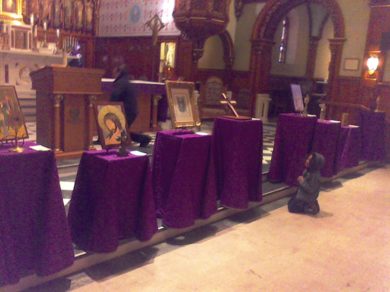April 26, 2017
Nine Holy Relics of the Passion displayed at Divine Mercy Shrine
REGIONAL
Story and photo by Toby Rogers, Special to iObserve

Lena Rogers, 6, a student at St. Mary School in Lee, kneels before the nine Relics of the Passion at the National Shrine of The Divine Mercy on Saturday, March 18.
STOCKBRIDGE – The National Shrine of The Divine Mercy recently hosted a conference that included the public display of nine Catholic relics that the Vatican regards to be authentic, holy artifacts from the time of Jesus Christ’s crucifixion.
Collectively called the “Relics of the Passion,” the nine relics include the Relic of the Holy Table; the Relic of the Column of Flagellation; the Relic of the Crown of Thorns; the Relic of the Veil of Veronica; the Relic of the Holy Nail; the Relic of the True Cross; the relic bone of St. Longinus; the Relic of the Burial Shroud; and the bone fragments of the 12 Apostles, minus Judas Iscariot.
Having a number of significant holy relics in one place is relatively rare and does not often take place outside the Holy Land or Rome.
“It was truly moving to see these holy pieces of Christian history up close, as small as they may be, they still can transport you back in time just as well as any large, historical architectural structure can,” said Ed Forfa, a member of the Knights of Columbus.
Since ancient times, Christians have preserved and honored physical objects associated with Jesus Christ, the Blessed Virgin Mary, and the holy men and women who are recognized as saints. These objects include items associated with Christ’s suffering and death, articles of clothing belonging to Mary, and the actual bodily remains of the saints themselves. These objects are commonly known as relics, and the practice of preserving and honoring them is known as veneration
According to Christian law and practice, no person or group may “own” a holy relic. Rather, a person or group in possession of a relic is its temporary guardian, charged with safeguarding it until such time as custody of the relic is passed along to another individual or group who will then assume responsibility for its guardianship. In this way, relics are passed from one generation to the next.
As a devotional practice, the veneration of relics has enjoyed varying degrees of popularity over the centuries. In medieval times, for example, veneration of relics played a prominent role in the daily life of European Christians. Oaths were sworn and vows were made in the presence of relics, which served as heavenly witnesses; relics were carried into battle, in the hope of securing divine aid and protection; persons afflicted with disease or with physical or mental infirmities were blessed with relics, which were viewed as instruments through which God could choose to effect miraculous healings; pilgrims seeking spiritual insight or divine favor undertook arduous journeys to famous pilgrimage sites where important relics were preserved; and traveling collections of relics were displayed in town after town as a means of instructing and inspiring the local populace. Artists fabricated richly decorated display cases, known as reliquaries, in which relics were safeguarded and displayed.
The once widespread practice of venerating relics has declined in recent times. Indeed, a number of parish churches, religious orders, and families, some of whom have served as guardians of relics for many generations, have sought a means by which they might dispose of these objects and thereby be relieved of their duties as guardians.
In the early 1990s, Thomas J. Serafin, a Roman Catholic layman, became aware of this situation, and made a personal commitment to accept custody and assume responsibility for relics in need of a guardian. Over the years, as Serafin’s commitment has become increasingly well known in both Catholic and Orthodox circles, more than 1,200 individual relics have been entrusted to Serafin’s care. As the number of relics under Serafin’s guardianship has grown, so has his international reputation as an author, lecturer, and expert on relics and their veneration.
The relics have been reviewed and authenticated by Vatican authorities prior to their first public tour in 2007. Since then, they have been venerated in more than 20 dioceses in the United States, Guam and the Philippines, where more than a million people came to see and venerate the rare relics.


 Facebook
Facebook Youtube
Youtube
